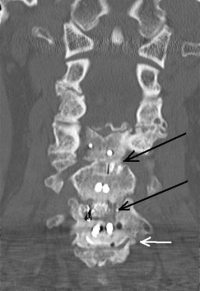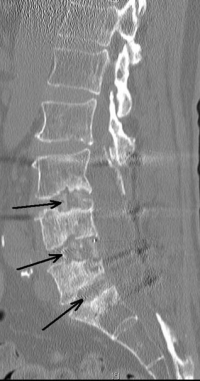Overview
The subject regarding failed spine surgery correction is a very broad topic. The reasons for failed spinal surgery are varied. The three possible conditions that are correctable are surgery that was done for the wrong diagnosis, a failed surgery that can be still be corrected such as a fusion that did not “take” (pseudoarthrosis) and a nerve that was not decompressed.
Wrong diagnosis is not as uncommon as would be expected. Finding the correct pain generator can be very difficult. Diagnostic imaging, diagnostic injections and a complete history and physical examination can reveal the source of complaints.
Are you a candidate for failed spine surgery correction?
Would you like to consult with Dr. Corenman about your condition?
You can set up a long distance consultation to discuss your
current X-rays and/or MRIs for a clinical case review.
(Please keep reading below for more information on this treatment.)
If a meticulous search for this generator was not completed prior to the first surgery, it can still be completed if the original surgery did not yield the anticipated relief.
If the surgery was not successful and the appropriate diagnosis was surgically corrected, the fault may be in the fusion or the placement of the artificial disc. A CT scan, bone scan or a new MRI on a better machine may give clues as to the reason the correct surgery did not work.
There are times that the correct diagnosis and the correct well done surgery without remaining nerve compression was performed. On those occasions, there may be no further surgery that can be helpful.
Chronic pain management may be in order. This end point can only be found by a significant work-up.
If you are seeking a second opinion for a failed spine surgery, please contact the office of Dr. Donald Corenman, spine surgeon and back pain specialist in the Vail, Aspen, Denver and Grand Junction, Colorado area.
Related Content
- Scoliosis Surgery
- Transforaminal Lumbar Interbody Fusion (TLIF)
- Posterolateral Fusion (PLF)
- Anterior Lumbar Interbody Fusion
- XLIF/DLIF Far lateral Interbody Fusion
- Microdiscectomy or Fusion?
- Minimally Invasive Lumbar Fusion
- Myths of Minimally Invasive Spine Surgery
- Myths of Laser Spine Surgery
- Indications for Lumbar Fusion
- X-Stop Procedure

(Click to Enlarge Image) This is an AP CT scan of a patient who had continued pain in his neck and arm after a cervical fusion. He was told the fusion was solid. Here, the upper black arrow points to a solid fusion of this level and the lower black arrow points to the level that did not fuse. The white arrow points to an uncovertebral joint spur that was compressing the nerve root at the level below that was not operated upon explaining his continued arm pain.

(Click to Enlarge Image) This is a revision surgery lateral X-ray of the same patient. The pseudoarthrosis (un-fused) level is now repaired and the level below where he had nerve root compression is now opened and the compression relieved. He had elimination of both neck and arm pain.

(Click to Enlarge Image) This is a CT scan of a patient who underwent a 3 level fusion of the lumbar spine. He had continued pain after surgery that increased in intensity. He was told that he had a solid fusion. The CT scan demonstrates that every level that had an attempted fusion did not go on to fuse (black arrows).
